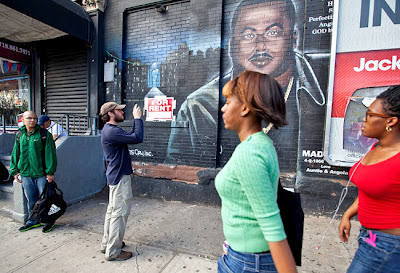I regularly say that LA is a tough town for tourists, especially European tourists. They’re used to going to Paris or Amsterdam or even New York, and when they’re there they do a lot of walking, expect to do a lot of walking, moving more or less effortlessly, from hotel to art gallery to restaurant to park, and so on, supplemented by public transport if necessary. This is the holiday experience. And then they come to LA where none of this applies.
That’s why so many LA tourists end up in Santa Monica or Venice, where walking is a reasonable thing to do, and a perfectly good way of getting around. Santa Monica has 3rd Street Promenade, Venice has its Ocean Front Walk, sometimes called the boardwalk though it’s a long time since there were any boards there, with its hippies, panhandlers, incense-sellers, body builders, street performers, and artists. (I was tempted to put that in inverted commas - “artists” – but hell, who am I to be a snot?)
Actually, the Venice ocean front was the scene of one of my more excruciating walking experiences. Back in the day, my then girlfriend and I, on a two week break from London, came to Venice and rented one of those four wheeled tandems, and we set off from the rental store at the south end of the boardwalk, and pedaled a couple of miles north - at which point we had a flat tire.
Even at the time, and many times since, I thought we should just have stayed on the tandem, ridden the damn thing back to the rental place, and if we’d shredded the tire and destroyed the wheel, well SFW? But they had my credit cards details and we’d no doubt have got stung with a punitive charge, so we did what was probably the best thing. We WALKED the tandem all the two couple miles back to the rental store. This would have been a little annoying in most circumstances, but essentially no big deal. However on the ocean front in Venice, there seemed to be a million people, all of them staring at us, all of them deeply fascinated, the best of them saying, “Oh, bummer, man.” But others saying, “What happened, man?” as if there might be some metaphysical explanation, others saying we should make sure to get a refund (I’d already thought of that, oddly enough), and several who claimed sufficient bicycle repair skills that they could fix it there and then if we pulled over and gave them a little time. We declined. It was, I think, the longest two miles I’ve ever walked, by no means the most arduous, but as I say, the most excruciating.
Well, as an Angelino, I have now learned pretty much never to go to Venice, but I was summoned there recently by Loretta Ayeroff, she of California Ruins fame, because she was participating in the Hammer Museum’s Venice Beach Biennial (that’s a geographical art pun). The idea was that “real” artists (inverted commas acceptable here, I think) would show their work alongside the boardwalk artists. So Loretta had a small exhibition space, actually a rectangle of tarmac next to the beach. This picture is by Sol Terringer:
Loretta had lived in Venice in the 1970s, and had taken pictures there including a set of people walking – she was now offering prints at $35 a pop - an unbelievably good price for a signed, numbered photograph by any photographer and absolutely amazing for an Ayeroff. However, business was both stressful and bad. I’m tempted to say she “couldn’t give them away,” but she did at least give one away – to me. It looks like this:
I love this picture. It shows people walking and of one person being (as it were) walked. Loretta says she thinks the two guys are Vietnam vets, which sounds perfectly likely. I also found myself reminded of Midnight Cowboy – Jon Voight and Dustin Hoffman, one messed up guy looking after some even more messed up guy.
You know, of course, that Hoffman put a stone in his shoe so he was forced to limp and didn’t have to “act” it – some seem to think this is another example of Hoffman’s vanity and absurdity but it actually sounds pretty reasonable to me.
Anyway, in order to people interested in her wares, Loretta started running a competition to see if anybody could recognize exactly where the photographs were taken. I was happy enough to join in. I didn’t for a moment expect to find the one story building on the left; that was surely long gone. But I did have vague hopes of spotting the large nondescript black on the right. I schlepped up and down looking at buildings, looking at change and decay, and indeed at some rebuilding and refurbishment, and I was damned if I could see anything that reasonably looked like that setting. I tried to talk myself into believing I could see some resemblance here and there, but in all honesty I found nothing.
By then I’d had enough, I decided to walk back, go say farewell to Loretta and leave, but I arrived at her show area, and she’d obviously been exhausted by the zoo that was Venice and there was no sign of her. Something quite symbolic there I think.
Loads more Ayeroff here:





















.jpg)

